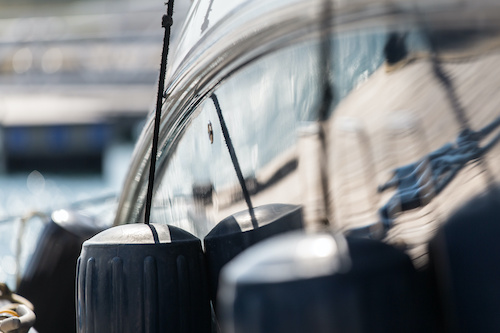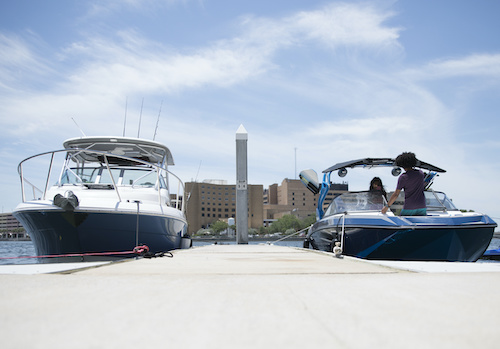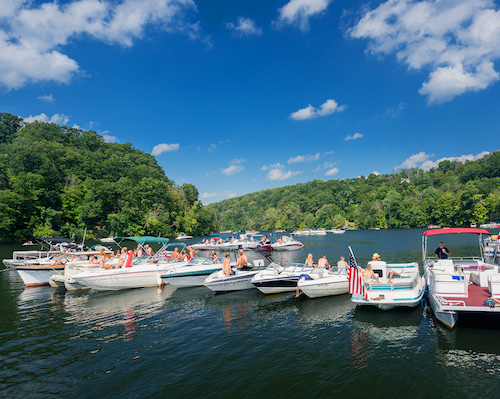Boat fenders, often referred to as "boat bumpers" by new or novice boaters, provide a cushion between your boat and a dock, jetty or another boat. They’re used by all types of boats from motor yachts and sailboats to small runabouts to prevent damage to paint, varnish, gunwales and hulls overall. A must-have boating accessory, fenders can help protect your boat (and your wallet) in case of a docking mishap or unexpected motion due to wind or current.
Let's take a closer look at the steps for rigging, or tying, a boat fender using the proper placement, and discuss the best boat fenders to use for your vessel type.
Boat Essentials: What Supplies Do I Need?
How to Use Boat Fenders
When it comes to attaching, deploying, or installing boat fenders on your boat, you'll want to consider three key factors: size, placement, and the number of fenders.
1. Choose the Right Size Fender(s)
You should size your fenders according to the size and type of your boat. The general rule of thumb is the smaller the boat, the less length and diameter is needed in a fender. That said, too small of a fender won’t protect your hull and can even get smashed when attached to too large of a boat.
For generic vinyl fenders, consulting a boat fender size chart can help—and there may be an applicable size range printed on the label of most fenders that are for sale.
2. Determine Proper Placement and Height
Most place or "hang" their fenders by spacing them equally. What you really need to do is to place them along the widest part of the hull, since that will most likely touch whatever you are docking next to first. Again, there are exceptions.
- If you dock with only your bow next to a jetty, then you’ll want most of your fenders there.
- Sometimes, you’ll need a fender when backing into a slip to avoid hitting the transom on the dock.
You'll also want to consider the height at which you hang the fender (or how high along the hull the fender is when tied on). How high or low the fender ends up is based on the dock or piling you're working with. Depending on the tide, fixed docks may present a too high or too low danger to your boat.
With floating docks, tying fenders so they’re just above the waterline will be a good solution. Take a good look at the situation and if you need time to adjust your fender setup, circle around until you’re ready.
3. Use the Right Number of Fenders for Your Boat
The number of fenders you need depends entirely on how you plan to use them, and based on the length of your boat—two to four fenders per side should work well for most boats.
You may also want an extra fender for what’s called a “roving fender,” that isn’t tied on, but instead, is managed by one of your crew and can be placed wherever needed at the last minute.
Always use caution when deploying a roving fender, and never use a body part (your arms, hands, feet, etc.) to "stop" or "slow" the momentum of boat as you approach the dock. Doing so can risk major injury.
How to Tie a Rope to a Boat Fender
Tying boat fenders involves two processes:
- Tying a rope to a fender (let’s call this a fender line);
- Tying the fender line to your boat.
Prepackaged vinyl fenders sometimes come with the line already attached (tied or spliced) to one end of a fender. They’re ready for use where fenders hang vertically along the hull.
If you have to tie a line to a fender yourself, a good knot to use is the bowline—as it’s strong, creates a loop that will go through one eye of the fender, and can be untied if needed even when serious strain has been applied to the line. Once a line is securely attached to a fender, you’ll rarely be untying it.
To tie a fender line to a boat (which is done every time you dock), the clove hitch will be a good choice.
- For many boats, you can attach a fender line to a cleat on your boat or on a dock (say, at a strategic and menacing dock corner). In this case, tie a simple cleat hitch that’s easy to put on and take off even with a significant load or when saltwater makes the line stiff.
- Many powerboats also tie fender lines to their guard railing and the clove hitch is ideal because it can slide along the rail to adjust placement at the last minute if needed.
- That said, to prevent damage to the overall railing, it’s best to tie fender lines to the bottom of stanchions where the railing is strongest with a lower leverage point (this applies to sailboats especially).
- Sometimes you can tie a line to either end of a fender and use it horizontally. This will cover a broader section of the hull but it works best when fending off a protruding vertical piling, for example.
How to Tie Up a Boat to a Dock
Type of Boat Fenders
There are three main types of fenders, and their use depends on the size of your boat, the docking situation at hand, and other extenuating circumstances.
Vinyl fenders
- These are the most common and can be purchased at nearly every chandlery (marine equipment store).
- They come in many sizes and even in a few colors. White is the most popular as it tends to not mar gel coat and paint.
- Vinyl fenders are typically cylindrical and inexpensive but when large, can be heavy. They get scuffed over time and tend to be hard to clean and harder to store.
That said, these make up the bulk of the fenders you’ll see in a marina and are used almost exclusively by small craft like sailboats, bowriders and pontoon boats.
Foam fenders
- These come in different shapes, often flat, so they don’t take up much room in a tight slip, which is helpful since fenders add width to your overall beam.
- They’re hard to store, especially when they’re large and they’re expensive. Also, the foam can disintegrate over time polluting the water and marking your hull.
Inflatable fenders
- These are made of various materials including PVC (like some dinghies).
- Because you can deflate them for storage, even large ones can be accommodated aboard.
- They’re typically lightweight and strong but quite expensive.
- Most of these are used by larger vessels that travel long distances and need to store them easily while under way.
Explore Docking Equipment & Anchoring Accessories
Additional Tips for Deploying Fenders in Certain Situations
There are some unique situations which will require individual judgement:
Raft Ups
Rafting up to another boat will require both vessels to have fenders, if possible. If the boats are of different heights, it’s best to put one set of fenders lower and the other higher off the waterline.
Catamarans (or Boats with Less Curvature)
Boats with less hull curvature (like catamarans) can touch farther down, near the waterline, so adjust as needed. Upon departure, be careful that the fenders don’t get tangled in one another. In that case, you may want to remove a few before departure so there’s less chaos.
Smaller Boats & Personal Watercraft (PWC)
Some smaller boats or personal watercrafts (PWCs) will have a fitting on the hull or deck that will allow you to “pop in” a fender that has a matching appendage at the end of its line. This is a bit rare but perfect because the fenders are preset for maximum protection of the hull and deck and can be added quickly even by those who can’t tie an effective knot. Many of these fenders are L-shaped to wrap around the hull/deck joint and are primarily used with small boats.
Finally, Don't Forget to Remove Your Fenders Once Underway
Once you're ready to get back underway, take up and stow your fenders. Many boaters who cruise with their fenders down take the risk of having one ripped off by a wayward wave. They also tend to be the butt of jokes by many experienced boaters, since they’re known as “landlubbers washing their bumpers.”






